 Download this page as an activity sheet (pdf, 168KB). Download this page as an activity sheet (pdf, 168KB).
Eggsperiments
In this activity, you can:
Please follow any safety instructions highlighted like this in red.
Is your egg fresh?
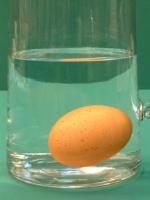 There's an easy way to tell if an egg if fresh or not and you don't have to break it open either! Carefully lower your eggs into fresh cold water using a spoon (you can do this in the pan if you're about to boil them). If the eggs stay at the bottom they're fresh; if the eggs float, however, they're stale and best avoided.
Make your fresh egg float
So, if a fresh egg sinks, how can I make it float? (and no, leaving a fresh egg long enough to go off doesn't count!) You can make a fresh egg float by dissolving salt in the water first. In fact, you can do an experiment to find out how much salt you need to add before the egg floats. Use a measuring jug of water and see how many tablespoons of salt you dissolve in the water before the egg starts to float.
 Water can only hold up things if they are lighter than the same amount of water – water can only hold up itself or any stuff lighter than itself. Such stuff is described as being less dense than water and it floats (for example, a piece of cork). Alternatively, stuff heavier than water is described as more dense than water and it sinks (for example, a coin). When a stale egg floats, it does so because the water is holding it up. If a stale egg floats in pure water it must be less dense than the water itself, whilst a fresh egg that sinks must be more dense than the water. Can you think why a stale egg would be less dense than a fresh egg?
Floating and sinking eggs – the science bit
As an egg ages, the water inside the shell slowly evaporates and is replaced by air, or by any gases that are produced as the egg rots (phew!). Many food products (vegetable, fruit, animal, etc.) give off gases when they go off, and they often smell! Eggs have such a distinctive, unpleasant smell when they go off that we talk about something "smelling like rotten eggs" (special precautions have to be taken at domestic waste tips to deal with the gases produced as rotting sets in). Anyway, as the egg gets older it ends up with more gas inside and less water, and the gas is lighter than the water. Overall, this makes the egg lighter and in fact less dense than water so that a stale egg floats.
Time for some more work for you: how do you know that a gas is lighter than water?
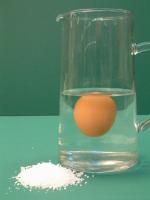 Now to the fresh egg which does float in salty water! You're probably getting the picture by now: a fresh egg sinks in pure water because it is more dense than the water, but can float when the liquid itself has increased in density. This happens when salt is dissolved in the water – the density increases and eventually exceeds that of the egg. You may have noticed yourself that it is easier to swim in the salty water of the sea compared with the water in a swimming pool or freshwater lake. That's because the salty water helps you to float. Further investigations
Can you think of anything else in the kitchen cupboards which would have the same effect as the salt? Which way up is the floating egg? Is it always this way? Do you know why?
Back to the top.
How to shell a raw egg
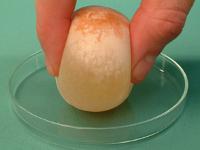 Try soaking your egg in vinegar! Place a raw egg in a glass, cover it completely with vinegar and leave it for a couple of days. Not that hard and neither is the egg – look how squeezy ours was! So what's going on? And what's it got to do with caves, kettle scale and acid rain?
By making some careful observations yourself, you can help work out what's going on. For instance, what do you notice on the surface of the egg as it sits in the vinegar? (It might be easier to see if you use colourless spirit vinegar rather than dark brown malt vinegar.)
What's happening to the egg shell? – the science bit
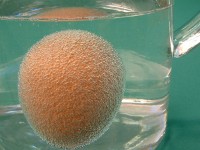 What you can see are bubbles of the gas carbon dioxide. We breathe out carbon dioxide and the same gas is produced by burning fossil fuels, contributing to the greenhouse effect. But where has this carbon dioxide come from? The egg shell itself – the hard shell is made of a material called a carbonate, which contains both carbon and oxygen atoms. Carbonates can be converted to carbon dioxide when they come into contact with materials known as acids. Vinegar is an acid (it's a dilute solution of acetic acid) and it converts the carbonate in the egg's shell to molecules of carbon dioxide gas. Each molecule of carbon dioxide has one carbon atom attached to two oxygen atoms, which is why it is sometimes referred to using the molecular formula, CO2 (pronounced "see oh two").
Another acid you can find in a supermarket is citric acid (chemists and home-brew suppliers also sell it). This is the purified, crystalline acid from citrus fruits, such as oranges, lemons and limes. You can make a concentrated solution of it in water that is stronger than the acetic acid in vinegar. This dissolves the egg shell more quickly, more completely and with less smell. You can find out more about acids here.
Back to the top.
Eggshells, caves, kettle scale and acid rain
In limestone regions, the rocks are made out of a form of calcium carbonate (mainly a mineral known as calcite), which is similar to egg shell. In fact, limestone rocks began their lives as the shells of marine organisms which accumulated to huge depths at the bottom of prehistoric oceans. Compressed into rocks over millions of years and raised upwards, they became the familiar limestone landscapes of areas like the Yorkshire Dales and Cheddar Gorge. Like eggshell then, limestone is attacked by acids and the role of acid is played in this case by rain water.
Rain water is acidic because of the carbon dioxide gas in the atmosphere (yes, that again!) which dissolves slightly in the water to make a weak acid called carbonic acid. The action of this acid causes the limestone itself to dissolve slightly, releasing minerals into the water and causing a number geological features typical of limestone country such as caves, stalactites and stalagmites. The formation of stalactites demonstrates that the process of dissolving limestone is reversible.
Stalagmites and stalactites
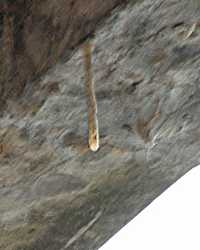 Drops of water on the ceiling of a limestone cave contain dissolved limestone rock. As the drop hangs there, water and carbon dioxide gas slowly evaporate from it leaving a small lump of limestone behind. This is the exact reverse of the process by which the limestone was dissolved initially by the rain water (carbonic acid). Another drop can now run down the lump and it too leaves behind a bit of limestone. Over time, fingers of limestone grow down from the ceiling. In a similar way, stalagmites begin to grow where the drips from the ceiling hit the cave floor. Eventually a stalactite can meet a stalagmite to make a kind of pillar. Look into the bottom of your kettle!
You can see this process in action in your own home if you live in a region with hard water. Hard water is water with lots of minerals dissolved in it and it usually originates from limestone areas in exactly the way described above. Heating hard water has the same effect as the evaporation process during stalactite formation: it drives the water and carbon dioxide away from the dissolved limestone, which is re-deposited as solid calcium carbonate.
 If you live in a hard water area, you only need to look inside your kettle to see your very own limestone landscape! Usually limestone is encrusted all over the element, the hottest part of the kettle. This can make your kettle very inefficient at boiling water so someone in your house probably cleans away this scale from time to time. Using your knowledge of limestone, can you think what kind of material would be used to achieve this?
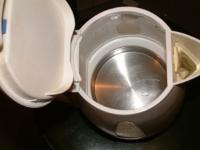 An acid, of course! Since you want to clean your kettle pretty quickly you need to use an acid that is stronger than vinegar but not so strong as to dissolve the kettle as well as the scale!
Many descaling products make use of citric acid as their active ingredient. You may also come across sulfamic acid used for the same purpose. Both are white solids that can be dissolved in water to make acidic solutions. Descaling products should be treated with respect and carry warnings about handling and usage. When added to a kettle that has scaled up, the carbon dioxide comes off in a dramatic, fizzing fashion. You must keep clear, as the bursting bubbles throw up fumes and acid drops that you mustn't let near your skin, eyes or face.
It never rains, it pours
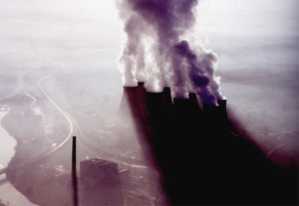 Rain water can also be acidic because of atmospheric pollution from cars, industry and power stations burning fossil fuels. These produce gases more acidic than carbon dioxide, containing sulfur or nitrogen atoms in combination with oxygen atoms. Rain which has become acidic owing to such pollution is described as acid rain and has a significant effect on the environment. Because limestone reacts with acids it provides a means of tackling acid rain. Limestone can be used as a scrubber in power station chimneys where it removes the acidic gases. However, this produces even more carbon dioxide which is a concern because of its contribution to the greenhouse effect rather than its acidity. In addition, the limestone is produced and transported (more carbon dioxide!) from huge unsightly quarries often in areas of outstanding natural beauty such as the Derbyshire and Yorkshire Dales. | 
